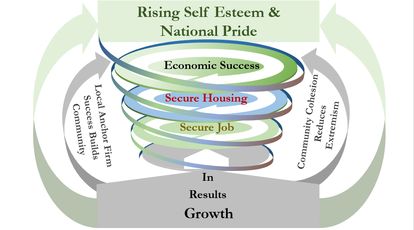Cumulative Causation is a framework that combines economic and social factors to reinforce each other to deliver a "virtuous cycle" growth or a "vicious cycle" of decline.

4 The economic theory of Cumulative Causation was developed by two economists in the period following 1945. Gunnar Myrdal, Swedish Economist looked at how social factors impact economic growth. His work on "Black America" was used as expert testimony for the landmark 1954 civil rights Supreme Court case Brown vs The School Board. Complementing this work, Nicholas Kaldor developed the economic theory relating to Cumulative Causation. Kaldor, who was a key adviser to the 1960's UK Labour Government, citing Verdoorn's Law, expressed growth as a function of the increasing returns to scale available in manufacturing. He argued that driving higher volumes in manufacturing reduced unit costs, making exports more price competitive and thereby driving export led growth.
Both Gunnar Myrdal and Nicholas Kaldor set their work within the a world of continual disequilibrium, thereby challenging the classic neoclassical growth model developed by Robert Solow. Mathematically, disequilibrium economics is far more challenging to model than the more conventional General Equilibrium and Partial Equilibrium constructs that underly so much of conventional economic theory and forecasting. There are many reasons for this, but one key element relates to the impact of uncertainty over time. Frank Knight's 1921 work that distinguished between risk (which can be statistically assessed) and uncertainty (that is an unknown) provides the intellectual underpin to developing growth and development models that accommodate continual market facing disruption. They also interleave, as does cumulative causation with Joseph Schumpeter's Theory of Economic Development.
This site is the consequence of our many years theoretical and practical work how to build dynamic innovative growing economies. In this work we have sought to integrate and update both pre-existing constructs for cumulative causation in to a dynamic construct that supports the "Entrepreneurial Capitalism" that will be key to delivering success in the post - industrial Industrial Revolution 4.0 of the current age. Our books and articles all develop different aspects of this framework. The blog on this site also introduces ideas and challenges in a more informal and shorter style.
Both Gunnar Myrdal and Nicholas Kaldor set their work within the a world of continual disequilibrium, thereby challenging the classic neoclassical growth model developed by Robert Solow. Mathematically, disequilibrium economics is far more challenging to model than the more conventional General Equilibrium and Partial Equilibrium constructs that underly so much of conventional economic theory and forecasting. There are many reasons for this, but one key element relates to the impact of uncertainty over time. Frank Knight's 1921 work that distinguished between risk (which can be statistically assessed) and uncertainty (that is an unknown) provides the intellectual underpin to developing growth and development models that accommodate continual market facing disruption. They also interleave, as does cumulative causation with Joseph Schumpeter's Theory of Economic Development.
This site is the consequence of our many years theoretical and practical work how to build dynamic innovative growing economies. In this work we have sought to integrate and update both pre-existing constructs for cumulative causation in to a dynamic construct that supports the "Entrepreneurial Capitalism" that will be key to delivering success in the post - industrial Industrial Revolution 4.0 of the current age. Our books and articles all develop different aspects of this framework. The blog on this site also introduces ideas and challenges in a more informal and shorter style.